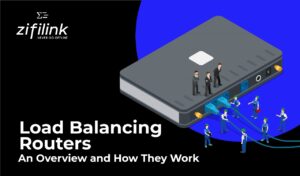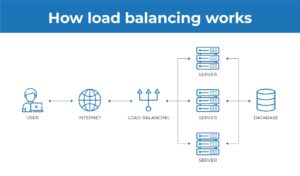Load Balancing Router: An Overview and How They Work

Load balancing router refers to the efficient distribution of incoming network traffic across a group of backend servers. High-traffic websites like Facebook, YouTube, and Wikipedia experience millions of requests every second, encompassing tasks such as video playback, page loading, content posting, image serving, running applications, and even simple flash games. Users demand speed, reliability, and a user-friendly interface, while the host seeks to handle relentless and massive traffic in a cost-effective manner. To address this, multiple servers are employed, and load balancers, including Benlycos Advanced Bonding Technology (B-ABT) and Benlycos Load Balancing Technology (BLBT), a groundbreaking solution, serve as vital components, functioning as traffic coordinators.
A load balancer, often referred to as a “traffic cop,” plays a critical role by evenly distributing traffic among all the servers based on the client’s requests. It operates on the principle of ensuring that each server receives its fair share of requests, thereby maximizing speed, optimizing resource utilization, and preventing any one server from becoming overburdened, which could lead to performance degradation. This same principle applies to load-balancing broadband routers, including innovative solutions like Zifilink and Bloom. These load balancing routers also function as internet bonding routers, effectively doubling their capabilities and further enhancing network efficiency and reliability.
The Role of an Internet Load Balancing Broadband
An Internet Load Balancer, also known as a load balance router, is a device designed to consolidate multiple broadband connections, including DSL (digital subscriber loop), cable, modem, or various wireless connections, into a unified channel. This technology allows users to connect multiple devices to the load balancer, which intelligently distributes traffic across the available connections. As a result, each device in your household can effectively utilize an individual IP address, ensuring optimal performance during data transfers, such as downloading and uploading.
The Internet Load Balancer combines and manages different high-speed internet connections, offering improved network performance for users. It leverages advanced technologies like BLBT (Benlycos Load Balancing Technology) and B-ABT (Benlycos Advanced Bonding Technology), along with innovative internet bonding routers like Zifilink, to support multiple internet connections efficiently. This approach ensures seamless and robust internet experiences by harnessing the collective capabilities of multiple broadband connections.
In today’s realm of modern networking, load balancers serve a multifaceted role that goes beyond merely distributing network traffic evenly. They exhibit remarkable adaptability and versatility, empowering them to execute advanced functions that elevate network performance and bolster reliability. Now, let’s delve into load balancing in four key points to better comprehend its significance in modern networking.
Key Points of Load Balancing Router
- Traffic Distribution Optimization: Load balancing routers are designed to efficiently distribute incoming network traffic across multiple internet connections or paths, preventing congestion on any single connection and ensuring optimal utilization of available resources.
- High Availability and Failover: Load balancing routers incorporate features to ensure high availability. If one internet connection fails, these routers automatically redirect traffic to the remaining operational connections, maintaining uninterrupted network services.
- Load Balancing Strategies: Various load balancing strategies are employed, such as Round Robin, Weighted Round Robin, Least Connections, and Least Response Time, each serving specific purposes in distributing network traffic effectively.
- Intelligent Routing and Security: Load balancing routers offer health monitoring to assess the status of internet connections and remove any malfunctioning ones. They also employ Network Address Translation (NAT) for enhanced security by obscuring internal network structures. Additionally, advanced routers can be application-aware, optimizing routing decisions based on specific application requirements.
- Resource Scalability: Load balancing routers are highly adaptable to changing network demands. Organizations can easily scale up their internet connections or upgrade existing ones to meet evolving requirements. This scalability allows businesses to efficiently expand their network capabilities without major disruptions.
More Advantages of a Load Balancing Broadband Router
A load balancing router ensures high efficiency with a minimal investment, providing reliable Ethernet connectivity and consistent network uptime. This device offers an easy, effective, and efficient means of managing your network, making it as convenient as managing a small convenience store. It typically features multiple ports that can be utilized for both LAN (local area network) and WAN (wide area network) connections. Additionally, the device automatically segregates and optimally utilizes the available bandwidth connections for efficient load distribution, ensuring optimal network performance.
A robust firewall incorporated into a load balance broadband router serves as a comprehensive defense against external threats. Many of these routers are equipped with advanced security measures, including the ability to automatically detect and mitigate threats such as the Ping of Death or DoS (Denial of Service) attacks. Furthermore, the device’s filtering capabilities play a crucial role in preventing virus and malware intrusions, enhancing your overall internet security and protecting your network from potential threats.
Load balancing routers are engineered with scalability as a core consideration. As your organization expands and network requirements intensify, these routers offer seamless adaptability to cater to increased traffic loads and the incorporation of additional connections. They grant the versatility to incorporate more internet connections or enhance existing ones with minimal disruptions to network operations. This inherent scalability empowers your network to evolve harmoniously with your business demands, facilitating efficient expansion and heightened performance as necessitated. Whether you are a growing small business or a large enterprise navigating dynamic network needs, load balancing routers deliver the essential scalability and adaptability to remain agile and competitive in today’s swiftly evolving digital landscape.
In Summary
With Zifilink, internet hassles become a thing of the past. Zifilink’s internet aggregator, powered by advanced technologies like BABT (Benlycos Advanced Bonding Technology) and BLBT (Benlycos Load Balancing Technology), is purposefully designed to provide users with an exceptional internet experience. It effectively eliminates concerns related to poor bandwidth or the inconvenience of finding oneself in remote areas with limited technology infrastructure.
Zifilink’s mission is to empower individuals by delivering high-speed and unwaveringly reliable internet services. By harnessing the capabilities of BABT and BLBT, Zifilink ensures that users can access the internet with confidence, knowing that they have access to a robust and optimized network infrastructure. Say goodbye to internet frustrations; with Zifilink, you can enjoy a seamless and dependable online experience, no matter where you are.
For enquiries and a firsthand experience of Load Balancing Routers, Reach Out to Us Today.




About The Author: Deepak
More posts by Deepak